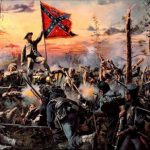These three years saw a conflict that really was a civil war, just as the Wars of the Roses in England were not. A real civil war splits the country, regions, families, married couples and best friends in two, for purely ideological reasons. England’s feudal War of the Roses was a series of basically private battles fought between members of a powerful aristocracy, employing their private armies, with the aim of securing the throne for one family or the other.
After the fall of Primo de Rivera in 1930, and the eclipse of the monarchy in 1931, Spain was split. On one hand there were the privileged (landowners, the church) and politically powerful groups such as the Falange; on the other were the Catalans and Basque separatists, along with republicans, socialists, communists and anarchicts. Elections in early 1936 gave power to a violently left-wing government and strikes, riots and military plots followed.
The Spanish Civil War arose from the growing resentment of Army leaders at the increasing marxist/socialist and anti-church tendencies of the Popular Front government of President Azaña. Socialist leader Negrin, too, had attempted to persuade Soviet Russia to accept Spain as one of the Soviet socialist republics, and this move had infuriated perhaps a half of the population; they did not wish to live as a puppet regime directed from Moscow.
The Civil War began as a revolt by military commanders in Morocco (then Spanish Morocco) on 18 July, 1936. The dissidents, haters of the 2nd Republic, and supporters of the disgraced and dislodged King Alfonso XIII, were led by General Sanjurjo (who was killed two months later), and a certain young officer called Francisco Franco. This officer had already shown certain skills in the defence of Spanish possessions in North Africa. He became ‘Chief of the Spanish State’ in October, 1936.
The Government of the 2nd Republic stayed in control of Madrid, Barcelona, Bilbao and Valencia, whereas Cádiz, Zaragoza, Sevilla and Burgos (among other cities) declared for the insurgents, who by now were calling themselves Nacionalistas. The rest of the world was horrified, trade agreements were torn up, and Spain became an open battleground for both fascists and socialists from many other countries including the United States, which sent the Lincoln Brigade to fight for the elected Government, with the help of the International Brigade, organised and financed to a great extent secretly by Britain and France. Russia, still interested in Spain as part of the Soviet Empire, sent war materiel, airplanes with their pilots and mechanics. Fascist Germany (10,000 men) and Italy sent tanks and aeroplanes and their crews too, and Spain became an ideological battleground.
The International Brigade was involved in heavy fighting along the banks of the River Ebro throughout 1938, but it was German air power (mainly the infamous Stuka) that contributed greatly to Franco’s eventual victory. The Stuka pilots perfected their dive-bombing techniques in Spain, which would, in the greater conflict that followed ‘this rehearsal’ prove so successful. There were at least 50,000 Italian ‘volunteers’ in the conflict, all professional soldiers.
Military Campaigns in the Spanish Civil War
These fall into four main phases: (a) During the first 6 months the advantages of surprise and superior military strength made it easy for the rebel nationalists to win most of their battles in the west and south. But the determination of urban workers and miners (from Asturias) and the desire of the Basques and Catalans for independence (which they would obviously not obtain from the nationalists), enabled the Government to rally resistance in the east and far north of the country. Sevilla, meanwhile, fell to a small group of nationalists who fooled the population into believing a much larger force was approaching.
By the end of 1936 Franco held more than half of Spain, including the entire length of the Portuguese border, a vital supply link. (b) In 1937 the nationalists tried to cut off Madrid and drive a wedge through Government territory by advancing from Teruel to Valencia. In both manoeuvres the nationalists failed. Then the International Brigade which was based in Madrid defeated a largely Italian force at Guadalajara. Later, with appallingly bloody fighting, and no quarter given on either side, Government troops recaptured Teruel. Bu the nationalists were meanwhile successful in the north. A force comprising Falangists, Carlists and Moroccan troops captured the Basque port of Bilbao in June. (c) In 1938 much larger support for the nationalists arrived from Germany and Italy, despite frantic attempts by the British and French to impose a policy of ‘non-intervention’. Thus the nationalists were able to resume the offensive throughout Spain. By August they had severed Government territory, following a 6-month thrust towards the sea. Through all the year Madrid withstood a siege and it was not until Christmas that the nationalists managed to break through on the Catalan front. (d) The Government was splitting because of internal division; there were intrigues and plots, and a massive change of Russian policy (cutting off aid) caused the Government forces to collapse in 1939. Barcelona fell on 26 January, and Valencia and Madrid surrendered on 28 March.
Dreadful atrocities were carried out without a trace of mercy by both sides throughout the Civil War. Whole villages were invaded by either side, and the populations shot and burned within the parish churches. Brothers killed each other. Women and children were not only not spared – they frequently joined in the fighting. At least three quarters of a million people lost their lives during this devastating Civil War. The wounds have not mended. The scars are still there. Many ardent socialists wish there could be a Round 2 – which they have every intention of winning. Hatred for the clergy, the military, the landowning aristocracy (though many Spanish aristocrats fought on the Government side) and the monarchy in Spain has not diminished, even now.










I must say I am Spanish and I appreciate the way you have written this article, with respect and being wary of certain details. Well done, you have a marvelous blog !